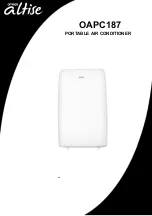
Page 7
AC13 SERIES
NOTE − Keep the height of extenders short enough to
ensure a sturdy installation. If it is necessary to extend
further, consider a different type of field−fabricated
framework that is sturdy enough for greater heights.
The inside diameter of the 4" (101.6mm) piping is
approximately 0.25" (6.35mm) greater than the
pre−installed feet on the unit. Devise a shim that will take up
the space and hold the extenders onto the feet during this
procedure. Small strips of 0.125" (3.175mm) thick
adhesive foam may be used. One or two small 1"
(25.4mm) square strips should be adequate to hold the
extender in place.
ELEVATING THE UNIT (LARGER−BASE UNITS)
Unlike the small−base units which use round support feet,
the larger−base units are outfitted with elongated support
feet as illustrated in figure 11 which uses a similar method
for elevating the unit.
If additional elevation is necessary, raise the unit by
extending the length of the unit support feet. This may be
achieved by using a 2" SCH 40 female threaded adapter.
The specified coupling will fit snuggly into the recessed
portion of the feet. Use additional 2" SCH 40 male threaded
adaptors which can be threaded to the female threaded
adaptors to make additional adjustments to the level of the
unit.
LEG DETAIL
BASE
2" (50.8MM) SCH 40
FEMALE THREADED
ADAPTER
Figure 11. Elevated Slab Mounting using Feet
Extenders (Larger Base Units)
ROOF MOUNTING
Install unit at a minimum of four inches above the surface
of the roof. Care must be taken to ensure weight of unit is
properly distributed over roof joists and rafters. Either
redwood or steel supports are recommended.
Removing and Installing Panels
CAUTION
To prevent personal injury, or damage to panels,
unit or structure, be sure to observe the following:
While installing or servicing this unit, carefully stow
all removed panels out of the way, so that the panels
will not cause injury to personnel, nor cause
damage to objects or structures nearby, nor will the
panels be subjected to damage (e.g., being bent or
scratched).
While handling or stowing the panels, consider any
weather conditions, especially windy conditions,
that may cause panels to be blown around and
battered.
REMOVING PANELS
Remove the louvered panels as follows:
1. Remove two screws, allowing the panel to swing open
slightly as illustrated in figure 12.
NOTE − Hold the panel firmly throughout this procedure
2. Rotate bottom corner of panel away from hinge corner
post until lower three tabs clear the slots as illustrated
in figure 12, detail B.
3. Move panel down until lip of upper tab clears the top
slot in corner post as illustrated in figure 12, detail A.
DETAIL A
Detail C
DETAIL B
ROTATE IN THIS DIRECTION;
THEN DOWN TO REMOVE
PANEL
SCREW
HOLES
LIP
PANEL SHOWN SLIGHTLY
ROTATED TO ALLOW TOP
TAB TO EXIT (OR ENTER) TOP
SLOT FOR REMOVING (OR
INSTALLING) PANEL.
IMPORTANT! DO NOT ALLOW PANELS TO
HANG ON UNIT BY TOP TAB. TAB IS FOR
ALIGNMENT AND NOT DESIGNED TO
SUPPORT WEIGHT OF PANEL.
Figure 12. Removing/Installing Louvered Panels
(Details A, B and C)








































